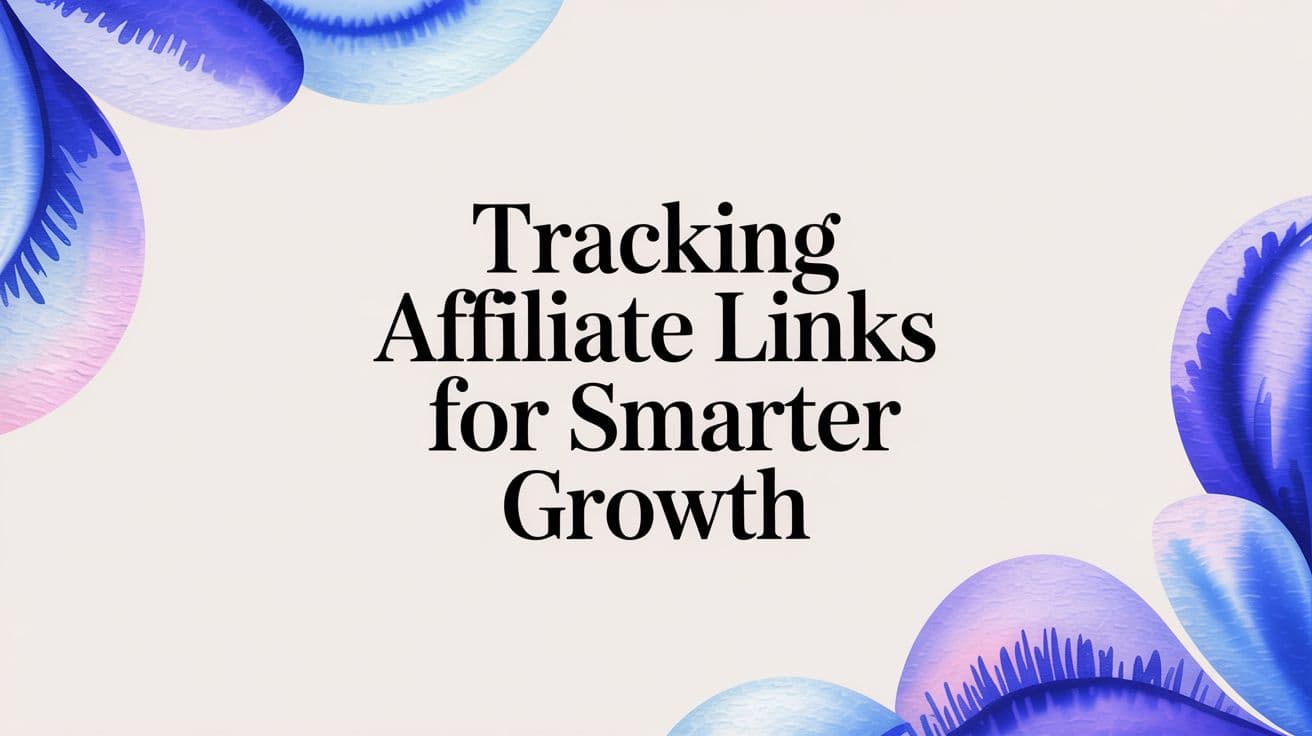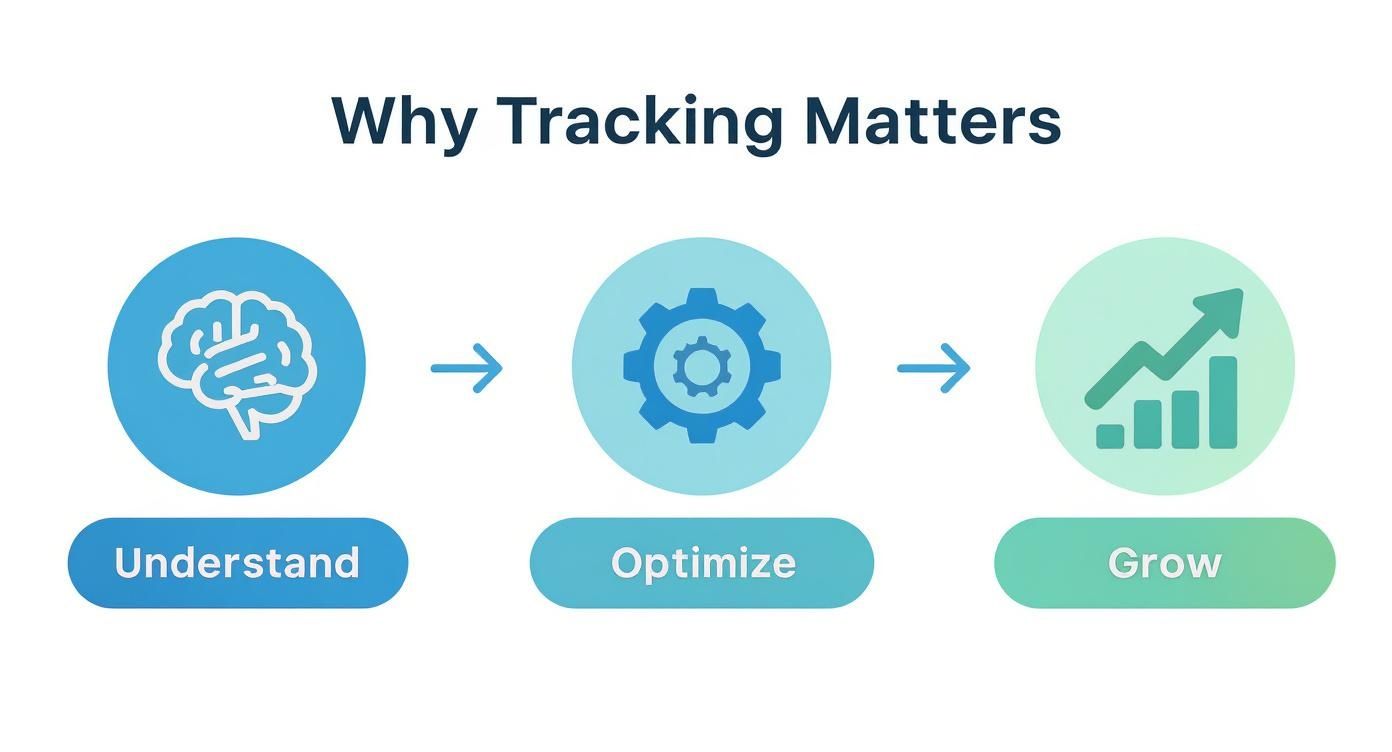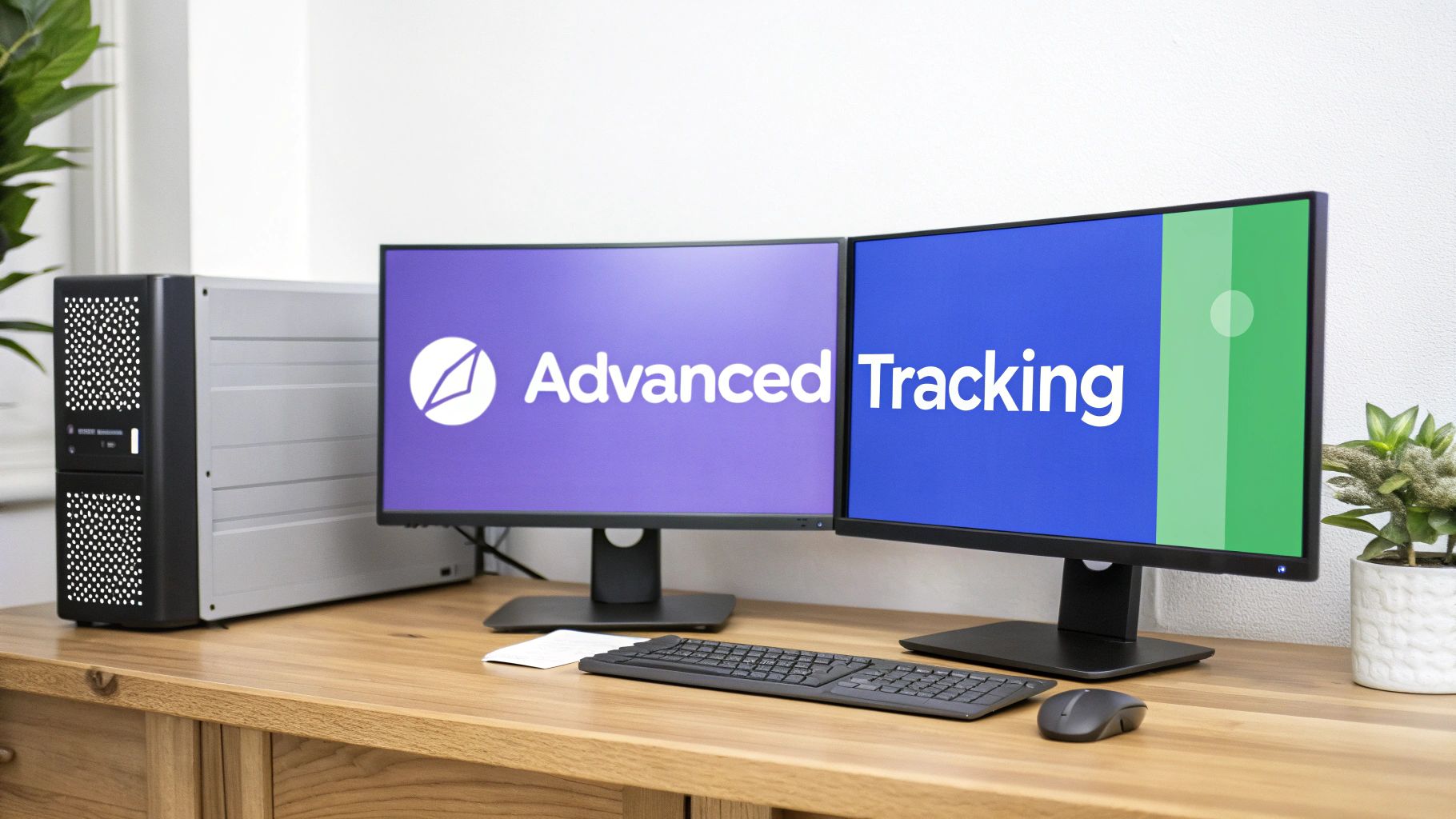Tracking Affiliate Links for Smarter Growth
Tracking Affiliate Links for Smarter Growth
Ollie Efez
November 07, 2025•15 min read

Tracking affiliate links is all about keeping tabs on the clicks, sales, and commissions your promotional links generate. It’s how you know which content is hitting the mark with your audience and, just as importantly, how you make sure you get paid for every sale you refer.
Why Bother With Accurate Affiliate Link Tracking?
Getting your affiliate link tracking right is more than just a box-ticking exercise to see if your commissions are coming through. It’s the very core of a smart affiliate marketing strategy. It takes you from throwing content at the wall and hoping something sticks to running a predictable, data-backed business.
Without solid data, you're flying blind. You might know you made a sale, but do you know why?
Imagine you wrote a super in-depth review of a product and also posted a quick video about it on social media. A commission rolls in. Fantastic! But which piece of content actually convinced someone to buy? If you don't know, you can't double down on what's working.
Find Out What’s Really Making You Money
Good tracking connects your efforts to actual results. When you know precisely which links are converting, you can start making some powerful moves.
- Pinpoint Your Best Content: Is it your long-form blog posts, your video tutorials, or your weekly email newsletter that drives the most sales? Now you'll know.
- Identify Your Star Products: Discover which affiliate products your audience can't get enough of. This tells you what to promote more and what similar products they might like.
- Fine-Tune Your Entire Strategy: Make smart decisions about where to spend your time and energy to get the biggest bang for your buck.
This is the kind of insight that separates the pros from the hobbyists. It's about working smarter, not just harder.
Accurate data is the bedrock of growth. Once you stop guessing what your audience wants and start paying attention to what their clicks are telling you, you can scale your affiliate income in a predictable way.
The Real-World Cost of Bad Data
The affiliate marketing world is huge and getting bigger. In the U.S. alone, spending is expected to hit $12 billion. This entire industry is built on tracking technology—things like unique URL parameters and tracking pixels, which over 80% of brands rely on. If you're not tracking your links properly, you're not just missing out on valuable insights; you're leaving money on the table from sales that aren't being credited to you.
To get a clearer picture of where the industry is heading, check out these powerful statistics from NewMedia.
But it's not just about lost commissions. Messy data can flat-out lie to you. It’s crucial to understand that not all tracking setups are perfect, and the numbers you see might not be the whole story. We dive deeper into this in our guide on why your affiliate data might be lying and how to fix it.
By putting a solid tracking system in place from day one, you protect your hard-earned revenue and ensure every click and conversion counts.
Building Your Foundational Tracking System
Alright, let's get down to business. Theory is great, but putting a solid tracking system in place is where you'll see real results. The good news is, you don't need to be a coding genius to do it. It’s all about setting up a clear, organized foundation right from the start so you know exactly what’s working and what’s not.
Your first step is to stop using the same generic affiliate link everywhere. Seriously. If you’re promoting a new software tool, you need a unique tracking link for your blog review, another for your YouTube tutorial, and yet another for your email newsletter. This one simple habit is the key to unlocking the granular data you need to grow.
The Power of Sub-IDs and Organization
Think of sub-IDs as little labels or tags you attach to your links. They are your secret weapon for drilling down into your performance data. For that software promotion I mentioned, your links might look something like this:
- For your blog post:
yourlink.com/product?id=123&subid=blogreview - For your YouTube video:
yourlink.com/product?id=123&subid=youtubetutorial - For your email newsletter:
yourlink.com/product?id=123&subid=emailq4
See how that works? A sale from the youtubetutorial link tells you instantly that your video is converting. Using a tool like LinkJolt makes creating and managing these variations a breeze, saving you the massive headache of trying to figure out where your sales came from later. If you want to get into the nitty-gritty of connecting this data to your other tools, our guide on technical integration can help: https://www.linkjolt.io/guides/technical/technical-integration.
This level of detail is non-negotiable in today’s market. Affiliate marketing now drives 16% of all e-commerce sales globally, and you can bet that the most successful affiliates are tracking everything. With over 90% of affiliate programs using unique tracking links, it's the industry standard.
This infographic really simplifies how this data-driven process works to fuel your growth.

It’s a simple loop: track your performance, use what you learn to fine-tune your strategy, and watch your efforts pay off.
Using UTM Parameters for Deeper Insights
If you want to go even deeper than sub-IDs, UTM parameters are your next best friend. They add another layer of detail, helping you track not just the channel but the specific campaign, ad, or piece of content that drove the click. Getting this right is a game-changer, so it’s worth digging into some UTM tracking best practices.
Key Takeaway: Stop treating all your links the same. By creating unique, organized links for every single placement, you turn a fuzzy picture of your performance into a crystal-clear roadmap showing what your audience actually wants.
When you have a proper system in place, you can see all of your campaign data in one clean dashboard. This allows you to spot trends and make smart decisions on the fly instead of getting buried in a mountain of spreadsheets. This foundational system is the launchpad for all your future affiliate marketing success.
Adapting to a Cookieless and Privacy-First World
The old ways of tracking affiliate links are officially on their way out. For years, we all relied on third-party cookies to see what was working. But with browsers cracking down and privacy laws like GDPR getting serious, that whole system is crumbling.
This isn't just a small shift; it's a huge challenge. If you're still using outdated cookie-based methods, you're going to see your data accuracy plummet. That means sales get misattributed, and you lose commissions you rightfully earned. It's time to adapt.
Future-Proofing Your Affiliate Tracking
So, what’s the fix? The future of tracking affiliate links is all about first-party data and more direct, reliable tracking methods. We have to stop depending on cookies that a user can block or delete with a single click.
This is where server-to-server tracking (you might also hear it called postback tracking) comes into play. It’s a much smarter way to connect the dots.
Here’s a quick rundown of how it works:
- The Click: Someone clicks your affiliate link. A unique click ID is instantly generated and attached to that user on the merchant's end.
- The Conversion: When that person buys something, the merchant’s server talks directly to your tracking platform’s server.
- The Result: It passes back that unique click ID, confirming the conversion without ever needing a cookie in the user's browser. It’s clean, accurate, and far more dependable.
This is exactly why platforms like LinkJolt were created—to handle this modern approach. They give you the tools for robust server-to-server tracking that keeps your data accurate while respecting everyone's privacy.
Adapting isn't just about following the rules; it's about building trust. When you use tracking methods that respect user privacy, you're sending a clear message to your audience that you value them. That’s how you build a business that lasts.
Thriving Without Third-Party Cookies
This whole evolution in affiliate marketing is a direct result of people caring more about their privacy. With the global industry now worth over $18.5 billion, the smart marketers are the ones embracing first-party data strategies. It’s not just about compliance; it’s about building a better relationship with your audience.
To stay ahead, you need to dive into robust cookieless tracking solutions that keep your data private and accurate. By focusing on first-party data and server-side tracking, you build a resilient system that doesn't care what browsers decide to do with cookies next.
This isn't just about protecting your revenue today. It's about setting up your affiliate business for long-term success in a world that puts privacy first.
Turning Tracking Data Into More Revenue

A dashboard packed with charts and graphs looks impressive, but let's be honest—those numbers are just noise until you use them to make smarter decisions. The real magic happens when you turn that raw tracking data into strategies that actually put more money in your pocket. It's time to stop chasing vanity metrics like total clicks and start focusing on what truly grows your income.
Forget about clicks for a second. Metrics like conversion rate and Earnings Per Click (EPC) are where the money is. A link with a ton of clicks but zero sales is just a dead end. On the flip side, a link with fewer clicks but a killer conversion rate is a goldmine.
Pinpoint Your Top Performers
Your first mission is to use your tracking data to find the winners. Jump into your LinkJolt dashboard and really dig into the patterns. Don't just glance at the overview; start asking questions.
- Which blog post is driving the most actual sales? Not just traffic, but confirmed commissions.
- Is my YouTube channel or my email list sending better-converting traffic for that new camera?
- Which specific product is my audience buying the most?
Maybe you'll discover that your "Top 10 Gadgets" listicle sends hundreds of clicks, but it's your deep-dive review of a single one of those gadgets that's generating 80% of your revenue. That’s a huge lightbulb moment. It tells you exactly what kind of content convinces your audience to pull out their wallets.
The goal is to stop guessing and start knowing. Your data is a direct line to your audience's purchasing behavior. Listen to what it's telling you, and you'll have a clear roadmap for what content to create next.
Systematically Boost Your Earnings
Once you know what’s working, you can start making it work even better. This is where small, consistent tweaks lead to big gains over time. A/B testing is your best friend here.
Got a high-traffic blog post with a link that isn't performing? Don't ditch it—optimize it. You can learn more about this in our guide on how to unlock hidden revenue by decoding affiliate data beyond just clicks.
Here are a few simple A/B tests you can run right away:
- Change the Call-to-Action (CTA): Does "Check Price on Amazon" outperform "Learn More Here"? Test it.
- Adjust Link Placement: What happens if you move the link from the bottom of the page to a more prominent spot up top?
- Try a Different Format: Instead of a plain text link, test an eye-catching product box or a comparison table.
By methodically tracking affiliate links and analyzing the results of these small experiments, you can systematically improve every piece of content you own. This isn't about luck; it's about building a predictable revenue engine, one tweak at a time.
Pro-Level Tracking Techniques to Scale Your Efforts

Alright, once you've got your basic link tracking system up and running smoothly, it's time to dig deeper. This is where you gain a real competitive edge. The simple methods tell you what converted, but these next-level techniques reveal the full story of how and why it happened.
Getting this bigger picture is what separates the affiliates who make a little extra cash from those who build a serious business.
The first big leap is moving beyond "last-click" attribution. Most affiliate programs, by default, give 100% of the credit to the very last link a customer clicked before buying. But what about the brilliant blog post they read three days ago that first introduced them to the product? Or the email you sent last week? Multi-touch attribution models give you a way to see and assign value to every single touchpoint along that customer's journey.
Last-click attribution is like giving all the credit to the person who scores the goal, ignoring the assists that made it possible. Understanding the full journey helps you appreciate and replicate the entire winning play.
Unlock Deeper Insights with Pixels and Parameters
To really get granular, you need to start using conversion pixels. A conversion pixel is just a tiny snippet of code that goes on the merchant’s "thank you" page after a purchase. When a sale goes through, this pixel fires and sends detailed data right back to your tracking platform, like LinkJolt.
This gives you rock-solid confirmation of sales and opens the door to much richer data, like the exact sale amount or even which specific products were purchased. It's worlds more accurate than relying on browser-based methods alone. Honestly, it's essential if you want a reliable picture of your performance.
Dynamic parameters are another game-changer. Let's say you're running a big Black Friday campaign. You want to track links across your blog, your email newsletter, and all your social media channels. Instead of creating dozens of separate, static links, you can use one base link and simply add unique parameters for each channel. This keeps your campaigns incredibly organized and your reporting crystal clear. You'll see exactly which promotions are driving results without a cluttered dashboard.
Demystifying Link Cloaking
Finally, let's talk about link cloaking. It might sound a bit technical, but it's really just the practice of turning a long, messy affiliate URL into a short, branded one using a tool like LinkJolt.
Instead of this monstrosity:
http://www.shareasale.com/r.cfm?B=12345&U=67890&M=54321&urllink=
Your audience sees a clean, simple link like this:
yourwebsite.com/recommends/product-name
For anyone serious about tracking affiliate links properly, cloaking is a no-brainer. Here’s why:
- Improved Trust and Aesthetics: Branded links just look more professional and trustworthy. People are more likely to click on something that looks clean and relevant, which means higher click-through rates for you.
- Enhanced Security: It effectively hides your unique affiliate ID from bad actors who might try to swipe your commissions.
- Centralized Management: This is huge. If a merchant ever changes their affiliate link structure, you only have to update it in one place—your LinkJolt dashboard. No more hunting down dozens of old links scattered across your entire website.
Attribution Model Showdown
Understanding how different models assign credit for a conversion is key to advanced tracking. Each one tells a slightly different story about your customer's journey.
By picking the right model for your goals, you can finally see which of your marketing efforts are truly driving results, from the first introduction to the final click.When you start combining these techniques—multi-touch attribution, conversion pixels, dynamic parameters, and smart link cloaking—you're no longer just reporting on clicks. You're building a strategic asset that fuels real, scalable growth.
Got Questions About Tracking Affiliate Links? Let's Clear Things Up
Even seasoned pros run into questions when setting up their affiliate tracking. It's totally normal. Let's walk through some of the most common head-scratchers I hear all the time so you can get your links live with confidence.
How Can I Be Sure My Tracking Is Actually Working?
This is the big one, right? You’ve set everything up, but how do you know it's working before you push a link out to thousands of people?
The easiest way is to run a quick "test click." Once you've created a new affiliate link in a tool like LinkJolt, just open an incognito or private browser window and click it yourself.
Hop over to your analytics dashboard, and you should see that click show up almost instantly. This simple, 30-second check confirms the basic plumbing is connected and can save you a massive headache—and lost commissions—down the road.
I can't tell you how many times I've seen people skip this step, only to find out a week later that nothing was being tracked. Always, always test your links.
Do I Need a Website to Track Affiliate Links?
Nope! This is one of the best things about modern affiliate marketing. You absolutely do not need a website to be successful.
The magic is in the unique URL you create, not where you post it. This opens up a world of possibilities for creators who live on other platforms. You can create your shortened, tracked links and share them anywhere, including:
- The description of your YouTube videos
- Your Instagram or TikTok bio
- Podcast show notes
- Emails and newsletters
As long as your audience clicks that specific link, the tracking system does its job and credits you for the referral. It's that simple.
What's the Real Difference Between Clicks and Conversions?
Getting this right is fundamental. Think of it this way: a click is a sign of interest. Someone saw your link and thought, "Hmm, I want to know more." It's the first step in the journey.
A conversion is the result. It’s the sale, the sign-up, the free trial—whatever the goal is. This is what actually puts money in your pocket.
You could have 10,000 clicks and zero conversions. That's not a tracking problem; it's usually a sign that what you promised in your content doesn't match what people find on the other side of the link.
Why Don't My Clicks Match the Numbers in the Merchant's Dashboard?
It's the classic "my numbers don't match their numbers" problem. Don't panic; this is more common than you'd think, and it rarely means something is broken.
Usually, the discrepancy comes down to a few things:
- Attribution Windows: The merchant might only give you credit for a sale if it happens within 24 hours of a click, while your system tracks the click indefinitely.
- Fraud Filters: The merchant's system might automatically filter out what it thinks are bot clicks or low-quality traffic, while your tool logs every single one.
- Ad Blockers: Sometimes, aggressive ad blockers can prevent a merchant's tracking pixel from firing correctly.
This is where using a robust platform that offers server-to-server tracking really shines. It creates a more reliable data connection that’s less likely to be blocked, giving you a much more accurate view of what’s really happening.
Ready to stop guessing and start seeing exactly what's driving your affiliate income? LinkJolt gives you the powerful, easy-to-use tools you need to track every click and conversion with confidence. Start optimizing your affiliate strategy today at https://linkjolt.io.
Watch Demo (2 min)
Trusted by 100+ SaaS companies
Start Your Affiliate Program Today
Get 30% off your first 3 months with code LINKJOLT30
✓ 3-day free trial
✓ Cancel anytime